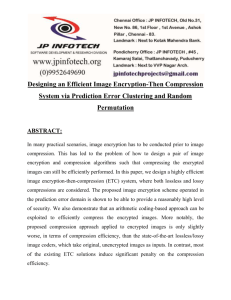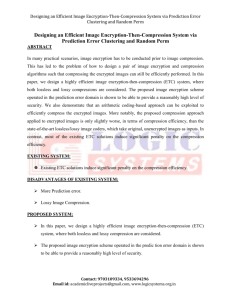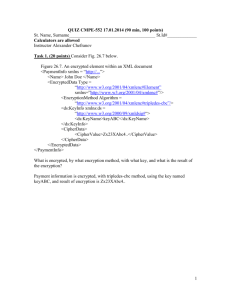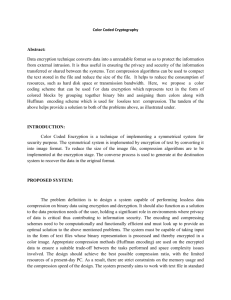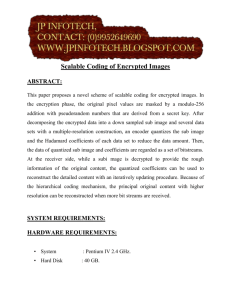Enhancement of Image Security Using Random Permutation
advertisement
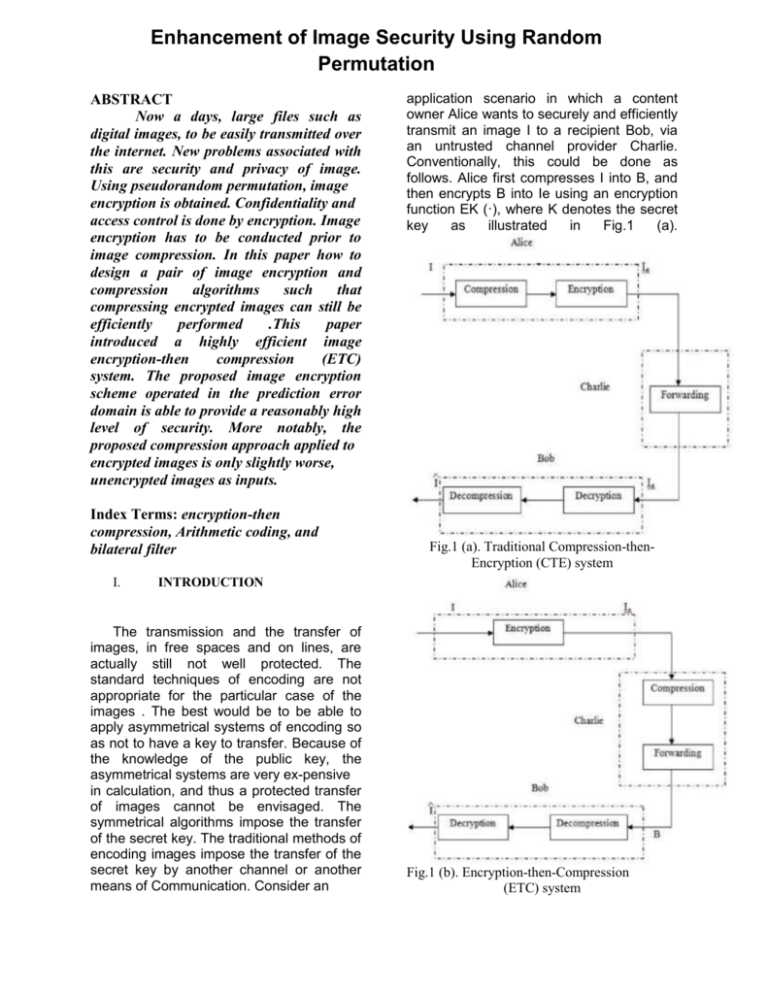
Enhancement of Image Security Using Random Permutation ABSTRACT Now a days, large files such as digital images, to be easily transmitted over the internet. New problems associated with this are security and privacy of image. Using pseudorandom permutation, image encryption is obtained. Confidentiality and access control is done by encryption. Image encryption has to be conducted prior to image compression. In this paper how to design a pair of image encryption and compression algorithms such that compressing encrypted images can still be efficiently performed .This paper introduced a highly efficient image encryption-then compression (ETC) system. The proposed image encryption scheme operated in the prediction error domain is able to provide a reasonably high level of security. More notably, the proposed compression approach applied to encrypted images is only slightly worse, unencrypted images as inputs. Index Terms: encryption-then compression, Arithmetic coding, and bilateral filter I. application scenario in which a content owner Alice wants to securely and efficiently transmit an image I to a recipient Bob, via an untrusted channel provider Charlie. Conventionally, this could be done as follows. Alice first compresses I into B, and then encrypts B into Ie using an encryption function EK (·), where K denotes the secret key as illustrated in Fig.1 (a). Fig.1 (a). Traditional Compression-thenEncryption (CTE) system INTRODUCTION The transmission and the transfer of images, in free spaces and on lines, are actually still not well protected. The standard techniques of encoding are not appropriate for the particular case of the images . The best would be to be able to apply asymmetrical systems of encoding so as not to have a key to transfer. Because of the knowledge of the public key, the asymmetrical systems are very ex-pensive in calculation, and thus a protected transfer of images cannot be envisaged. The symmetrical algorithms impose the transfer of the secret key. The traditional methods of encoding images impose the transfer of the secret key by another channel or another means of Communication. Consider an Fig.1 (b). Encryption-then-Compression (ETC) system The encrypted data I is then assed to Charlie, who simply forwards it to Bob Upon receiving I Bob sequentially performs decryption and decompression to get a reconstructed image I. Even though the above Compression-then-Encryption (CTE) paradigm meets the requirements in many secure transmission scenarios, the order of applying the compression and encryption needs to be reversed in some other situations. As the content owner, Alice is always interested in protecting the privacy of the image data through encryption. Nevertheless, Alice has no incentive to compress her data, and hence, will not use her limited computational resources to run a compression algorithm before encrypting the data. This is especially true when Alice uses a resource-deprived mobile device. In contrast, the channel provider Charlie has an overriding interest in compressing all the network traffic so as to maximize the network utilization. It is therefore much desired if the compression task can be delegated by Charlie, who typically has abundant computational resources. A big challenge within such Encryption-thenCompression (ETC)[7] framework is that compression has to be conducted in the encrypted domain, as Charlie does not access to the secret key K. This type of ETC system is demonstrated in Fig.1 (b). II. PROPOSED WORK The proposed system consists of the three key components namely, image encryption conducted by Alice, image compression conducted by Charlie, and the sequential decryption and decompression conducted by Bob. A. Image Encryption via Prediction Error Clustering and Random Permutation Encryption refers to set of algorithms, which are used to convert the plain text to code or the unreadable form of text, and provides privacy. To decrypt the text the receiver uses the “Secret key” for the encrypted text. The feasibility of lossless compression of encrypted images has been recently demonstrated by relying on the analogy with source coding with side information at the decoder. Upon receiving the compressed and encrypted bit stream B, Bob aims to recover the original image I . A multimedia technology for information hiding which provides the authentication and copyright protection. Fig:2 Schematic diagram of image encryption. The algorithmic procedure of performing the image encryption is then given as follows: Step 1: Compute all the mapped prediction errors ˜ei,j of the whole image I. Step 2: Divide all the prediction errors into L clusters Ck, for 0 ≤ k ≤ L − 1, where k is determined by (5), and each Ck is formed by concatenating the mapped prediction errors in a raster-scan order. Step 3: Reshape the prediction errors in each Ck into a 2-D block having four columns and ⌈|Ck|/4⌉ rows, where |Ck| denotes the number of prediction errors in Ck. Step 4: Perform two key-driven cyclical shift operations to each resulting prediction error block, and read out the data in rasterscan order to obtain the permuted cluster ˜C k. Step 5: The assembler concatenates all the permuted clusters Ck, for 0 ≤ k ≤ L−1, and generates the final encrypted image. in which each prediction error is represented by 8 bits. As the number of prediction errors equals that of the pixels, the file size before and after the encryption preserves. Step6: Pass Ie to Charlie, together with the length of each cluster |˜C k|, for 0 ≤ k ≤ L − 2. The values of |˜C k| enable Charlie to divide Ie into L clusters correctly. In comparison with the file size of the encrypted data, the overhead induced by sending the length |˜C k| is negligible. B. Compression of Encrypted Image via Arithmetic Coding The compression of the encrypted file Ie needs to be performed in the encrypted domain, as Charlie does not have access to the secret key K. In Fig. 3, we show the diagram of compression of Ie. Assisted by the side information|˜C k|, for 0 ≤ k ≤ L − 2, a de-assembler can be utilized to parse Ie into L segments ˜C 0, ˜C 1,・・, ˜C L−1 in the exactly same way as that done at the encryption stage. An AC is then employed to encode each prediction error sequence ˜C k into a binary bit stream Bk. Note that the generation of all Bk can be carried out in a parallel manner to improve the throughput. An assembler concatenates all Bk to produce the final compressed and encrypted bit stream B, namely, B = B0B1 ・ ・ ・BL−1 C. Sequential Decompression and Decryption Fig. 3. Schematic diagram of compressing the encrypted data. Arithmetic coding Arithmetic coding is especially suitable for small alphabet (binary sources) with highly skewed probabilities. Arithmetic coding is very popular in the image and video compression applications. Consider a half open interval [low, high).Initially, interval is set as [0, 1) and range=high -low = 1-0 = 1.Interval is divided into cumulative probabilities of n symbols. For this example, n=3; p (a) =1/2, p (b) =1/4 and p(c) =1/4.We propose an image encryption scheme operated over the prediction and permutation based image encryption method and the efficiency of compressing the encrypted data. Fig. 5. Schematic diagram of sequential decryption and decompression. After receiving the compressed and encrypted bit stream B, Bob aims to recover the original image I. The schematic diagram demonstrating the procedure of sequential decryption and decompression is provided in Fig. 4. According to the side information |Bk|, Bob divides B into L segments Bk, for 0 ≤ k ≤ L−1, each of which is associated with a cluster of prediction errors. For each Bk, an adaptive arithmetic decoding can be applied to obtain the corresponding permuted prediction error sequence ˜C k. As Bob knows the secret key K, the corresponding de-permutation operation can be employed to get back the original Ck. With all the Ck, the decoding of the pixel values can be performed in a raster-scan order. For each location (i, j), the associated error energy estimator _i,j and the predicted value ˜Ii,j can be calculated from the causal surroundings that have already been decoded. Given _i,j , the corresponding cluster index k can be determined by using (5). The first ‘unused’ prediction error in the kth cluster is selected as ˜ei,j , which will be used to derive ei,j according to ˜Ii,j and the mapping rule described in Section II-A. Afterwards, a ‘used’ flag will be attached to the processed prediction error. The reconstructed pixel value can then be computed by ˆIi,j = ˜Ii,j + ei,j (9) As the predicted value ˜Ii,j and the error energy estimator _i,j are both based on the causal surroundings, the decoder can get the exactly same prediction ˜Ii,j . In addition, in the case of lossless compression, no distortion occurs on the prediction error ei,j , which implies ˆIi,j = Ii,j , i.e., error-free decoding is achieved. III. Performance measures To study the relative performance of cluster based segmentation methods the following quality measures are calculated. Peak Signal to Noise Ratio (PSNR) PSNR is most commonly used to measure the quality of for image compression. The signal in this case is the original data, and the noise is the error introduced by compression. When comparing compression, PSNR is a human perception of reconstruction quality. The PSNR is calculated based on color texture based image segmentation. The PSNR range between [0, 1), the higher is better. Mean Square Error (MSE) Mean Square Error (MSE) is calculated pixel-by pixel by adding up the squared difference of all the pixels and dividing by the total pixel count. MSE of the segmented image can be calculated by using the Equation. The MSE range between [0, 1], the lower is better. IV.RESULTS Sample Results of (a) original Lena; (b) encrypted Lena; (c) original Baboon; (d) encrypted Baboon. (a) Original Image (b)Encrypted Image References (a)Encrypted Image (b)Reconstructed Image Quality Measures of Image Image Lena Quality Measures PSNR MSE Original Image 23.86 dB 267.12 Encrypted Image 26.55 dB 144.00 Reconstructed Image 32.11 dB 39.98 V.Conclusion In this paper, we have designed an efficient image Encryption-then Compression (ETC) system. Within the proposed work, the image encryption has been achieved via prediction error clustering and random permutation. Efficient compression of the encrypted data has then been done by arithmetic coding approach. By Arithematic Coding based, Coding Can’t be Cracked. Both theoretical and experimental results have shown that reasonably high level of security has been retained. The coding efficiency of our proposed compression method on encrypted images is very close to that of the image codecs, which receive original, unencrypted images as inputs. TheCompressed image is measured in terms of Quality measures like MSE and PSNR. [1] J. Zhou, X. Liu, and O. C. Au,“ On the design of an efficient encryption thencompression system,”[2] T. Bianchi, A. Piva, and M. Barni, “On the implementation of the discrete Fourier transform in the encrypted domain,” IEEE Trans. on Inf. Forensics Security, vol. 4, no. 1, pp. 86-97, March 2009. [7] M. Johnson, P. Ishwar, V. M. Prabhakaran, D. Schonberg, and K. Ramchandran, “On compressing encrypted data,” IEEE Trans. on Signal Process., vol. 52, no. 10, pp. 2992-3006, Oct. 2004. [9] D. Schonberg, S. C. Draper, and K. Ramchandran, “On compression of encrypted images,” in Proc. IEEE Int. Conf. Image Process., pp. 269 -272, 2006. [13] W. Liu, W.J. Zeng, L. Dong, and Q.M. Yao, “Efficient compression of encrypted grayscale images,” IEEE Trans. on Image. Process., vol. 19, no. 4, pp. 1097–1102, April 2010. [15] A. Kumar and A. Makur ,“Lossy compression of encrypted image by compressing sensing technique,” in Proc. IEEE Region 10 Conf., pp.1-6, 2009. [21] X. Wu and N. Memon, “Context-based, adaptive, lossless image codec,”IEEE Trans. On Commun., vol. 45, no. 4, pp. 437–444, April 1997.
